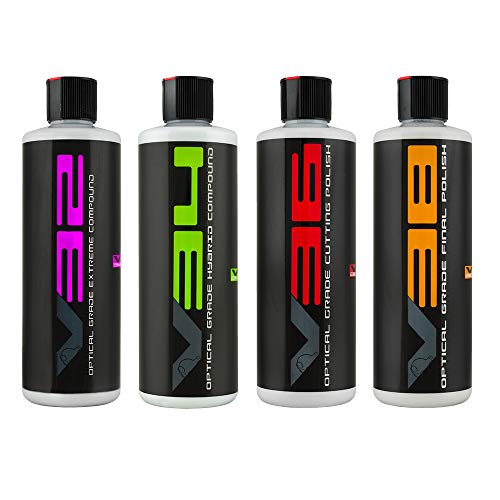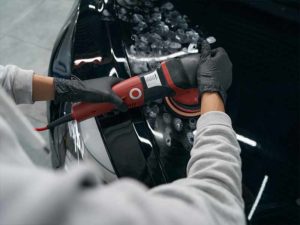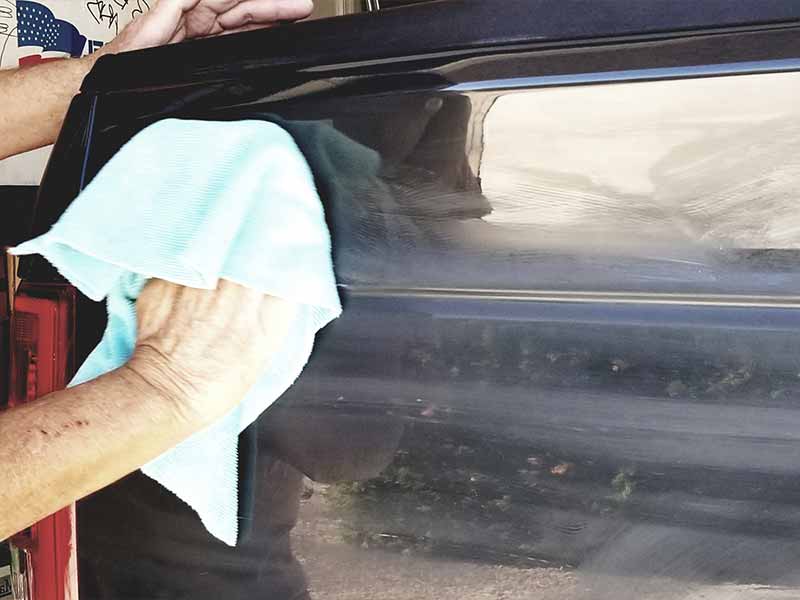Table of Contents
Swirl marks may represent fine scratches in your paint due to improper car washing, but they can also be a product of correcting paint. To avoid swirl marks when buffing, use a dual-action polisher. Whether you’re cutting or polishing, the dual-action decreases the chances of visible swirls.
In this article, we’ll show you how to avoid swirl marks, as well as methods you can use to prevent them. Swirl marks are not permanent, but they can cause lasting damage to your paint if left untreated. There are many myths surrounding swirls, many of which we’ll address later on.
How To Avoid Swirl Marks When Buffing
- Decontaminate your paint thoroughly before beginning
- Be sure to use a dual-action polisher
- Always use clean pads
- Let the buffer do the work and don’t use excessive force
- Keep the pad level with the paint surface
- Always ensure there is plenty of product on your pad
How To Prevent Swirls And Holograms While Polishing
Here are the key points to ensuring you don’t create unsightly swirls and holograms in your clear coat while buffing out old swirls and fine scratches:
Decontaminate your paint thoroughly before beginning
Obviously you’ll want to wash your dirty car or truck thoroughly immediately prior to buffing and polishing. But it’s also important to decontaminate the paintwork surface too. Using a clay bar to remove any stuck on debris and road grime is important to ensure the polishing pad doesn’t pick up grit and swirl it around. Once you’re finish is completely free of dirt and grit you can begin.
Be sure to use a dual-action polisher
Dual-action polishers have some important benefits to reducing the chance of creating light swirls and scratches. The dual in dual-action means that the polishing pad doesn’t simply spin. It also oscillates the spindle of the rotating pad. This helps prevent build up of heat and pressure in a single spot that can more easily cause swirls and holograms.
Another important feature of a good quality dual-action polisher is that it will stop spinning when too much pressure is applied. It’s important to allow the polisher to do the work. It’s also important to use the polisher correctly. If the pad isn’t parallel to the paintwork too much pressure can get applied to one side of the spinning pad and burn through the finish. Since a dual-action polisher will stop spinning if too much pressure is applied, this scenario is much less likely to happen.
Always use clean pads
Using clean pads is critical to ensuring that any grit from previous work doesn’t damage your finish. Polishing pads are relatively inexpensive and it’s not unreasonable to toss a polishing pad after a single use to be safe.
Let the buffer do the work and don’t use excessive force
As mentioned earlier, too much pressure can cause the polisher or buffer to begin wearing away too much material. Using a random orbital polisher is a smart choice for newbies and veterans alike.
Keep the pad level with the paint surface
Ensuring the polishing pad is perfectly even with the paint surface is important to ensuring that pressure is even. If only one edge of a polisher is hitting your finish it can easily overheat a single spot and damage your paintwork. Random orbital polishers help prevent this problem.
Always ensure there is plenty of product on your pad
Polish not only has a fine grit that allows the remove of fine swirls, scratches, and holograms, but it also lubricates to prevent the pad from working too aggressively.

How to Prevent Swirl Marks When Washing Your Car Or Truck
Follow these best practices to prevent swirl marks:
- Always use a clean wash mitt or sponge when washing your car. Dust and dirt can do more harm than good if they’re in the mitt as well as on the paint.
- Wiping a dirty wash mitt/sponge across the paint in circular motions causes swirl marks, especially if you’re applying lots of pressure to the surface of the paint.
- A bucket of soap and hot water makes washing your car easier. If you’d like, you can use a two-bucket system, where you rinse your sponge/wash mitt every time after making a pass over your car.
- Washing and drying your car involve similar motions. When drying your car, use a clean microfiber. A quality microfiber towel will be soft enough not to leave fine scratches in the paint.
- Applying a coat of wax every 3-6 months will help protect your paint. Depending on your climate and driving habits, the wax creates a layer of protection that will last through a few car washes.
- Use a dual-action polisher to remove any swirling defects from paint correction. Keeping it low and slow, treat the paint with polish to enjoy lasting, glossy effects.
Preventing swirls is one thing, but removing them is quite another. Before we get into specifics, let’s clarify a few terms.
Buffing vs. Polishing
Often the terms “buffing” and “polishing” are used interchangeably. “Buffing” refers to the process of paint correction, whether that’s with a rotary machine or a dual-action polisher.
As the term implies, “polishing” refers to the process of increasing the luster of the paint’s finish, i.e., achieving a high-gloss shine or polish.
Polishing typically occurs after buffing. The buffing process is where swirl marks can appear, as the compound cuts deeply into the clear coat to remove any imperfections.
Certain polishing compounds can also address defects in the paint, but their primary purpose is to restore shine. Polishing with a dual-action machine helps to do away with any swirls created in the buffing process.
Both buffing and polishing can be done with the same machine. The difference is in the RPMs. Cutting compounds frequently require a higher range of RPMs to generate heat and activate the grit of the compound itself.
Polishes still have a certain amount of grit but can be used at lower speeds. Dual-action polishers will leave fewer swirls than rotary buffers, no matter what RPM is used.

What Are Swirl Marks
Swirl marks are easiest to see on a black or dark-colored car, especially those without metallic flake. White cars can certainly still exhibit swirls. They’re just not as easily seen. Silver and light gray paints typically hide swirl marks best, besides white painted cars.
There are two main types of swirl marks: fine scratches and those that appear during paint correction.
Microscopic Scratches
The most common cause of swirl marks stems from fine debris that’s dragged across your car’s paint. These marks happen when you wash your car, whether it’s by hand or through an automated car wash. Most people wash in circular motions, which sweep the debris in swirling patterns across the paint’s surface.
Automated car washes move in pre-programmed patterns, so habitual use of the same car wash can deepen those fine scratches. The swirls become more apparent the more often you wash your car, which may seem counterintuitive.
But any dirt or debris on the surface of the paint gets pushed down by the brushes and again swirled across the paint over and over.
Cutting Compound Defects
Swirl marks are caused by a combination of things, such as a gritty compound on a rotary machine equipped with a wool pad. The clear coat dulls as the compound is applied to remove imperfections, and the swirling marks follow the path of the wool pad as the buffer machine goes over the paint. This creates the circular, or swirling, effect.

How to Remove Swirl Marks
For a swirl-free paint finish, you can use your hands or a machine. Below is an explanation of both processes, each with its pros and cons.
De-Swirl Your Car By Hand
Removing swirls by hand takes a bit more time and effort, but it can be worth it. You could make up for what you lack in power in terms of saving money and preventing any further damage if you’re not sure how to use a buffer/polisher.
The first step in removing swirls entirely by hand is to prep the surface of your car’s paint. You can do this with an IPA solution, lacquer thinner, or simply by washing your car thoroughly.
You’ll also want to invest in a few types of compounding products with various grittiness. A more aggressive grit will cut deeper into your clear coat but also remove heavier scratches.
Compounds are formulated to work with specific pads, too. These pads come in various thicknesses and stiffness factors, depending on which compounds they’re paired with. Grittier compound products are typically paired with stiffer pads, while polishing pads frequently are the softest.
Check out our article to learn more about how to remove swirl marks by hand.
If you’re not feeling like a workout, keep reading to see how you can achieve the same results with a machine.
Remove Swirl Marks with Power
The best way to remove swirl marks with a polisher is to invest in a solid polishing compound. These compounds have a fine grit to them but are mostly a fine liquid meant to be used at a lower speed.
Polishing dual-action machines deliver the best results compared to a buffer, as the infinity shape-like movement dispels circular patterns altogether.
Polishing compounds work best with soft polishing pads. Foam pads work well, as they flex a bit to accept the heat built up by the polisher. A lower RPM setting and slow movements across the paint allow the polishing compound to work correctly. Overlapping passes will ensure a smooth, glossy finish.
Once you’ve polished the paint, simply remove any remaining product with a microfiber towel. Soft microfiber towels work the best as they won’t undo your efforts.

Frequently Asked Questions
How do I protect my car from swirl marks?
Protecting your car or truck from swirl marks involves more than just proper technique when buffing and polishing. Good washing and drying techniques are critical. Touchless washing and drying are great if you have the tools and your vehicle isn’t too dirty. The 2-bucket method is best if a touchless wash isn’t enough to get your vehicle properly clean.
Are swirl marks permanent?
No. Swirl marks can be removed, assuming they are only in the clear coat of your paintwork. Scratches that go deeper than the clear coat will need to be either touched up, or the vehicle will need to be repainted.
Swirl marks on a black car vs. white car
Swirls on a black car are easily seen and look terrible but are less noticeable on white vehicles. Despite this, a white car will still look dull due to fine swirls and scratches. Picking a white car over a black car will improve the look of your finish over time, but it isn’t the only factor.
What color hides swirl marks?
Lighter colors hide swirls and fine scratches best. Even the best color for hiding swirl marks will look dull and old if it is covered with fine scratches and swirls, though.
Why am I getting swirl marks when buffing?
Swirl marks are caused during buffing generally due to poor technique. There are other factors, though. It’s essential to use a quality dual-action polisher, clean pads, avoid excessive pressure, and keep the polishing pad even with the surface of the paintwork.
How do you get rid of buffing swirl marks?
Buffing swirl marks are caused by improper technique when trying to remove fine swirls and scratches. To remove buffing swirl marks, you’ll need to repeat another pass, but you should be sure you’re using the proper technique to avoid causing any more defects.
What RPM should you buff a car?
2500 rpm is appropriate for more difficult swirls, while closer to 1000 rpm is best for lighter swirls and fine scratches. It’s important to remover though that rpm should factor in the grit of the polish or compound and the hardness or aggressiveness of the pad as well.
Does ceramic coating remove swirl marks?
No. Ceramic coatings are coatings, as the name implies. They don’t polish the finish in any way. A ceramic coating can help prevent fine swirls and scratches since they are tough coatings.
Does clay bar remove swirls?
No. Clay bars remove surface contaminants and don’t do any polishing or otherwise affect the clearcoat. Clay bars can potentially cause swirls and scratches if not used carefully, however.
What is the best polish to remove swirls?
The best polish will be the one that is the least aggressive but can still effectively remove the swirls in a reasonable amount of time. I wouldn’t get too hung up on which brand of polish to choose. Pick one and get to know how it works.
What's the difference between a buffer and a polisher?
They’re essentially the same device. I tend to think of buffers as the old-school machines and polishers as the new dual-action machines, but the truth is they’re just different names for the same machine.
How much does it cost to remove swirl marks?
Swirl mark removal is commonly referred to as paint correction. Paint correction is very labor and time-intensive job and therefore is quite expensive. Small paint correction jobs may only cost a few hundred dollars, while larger jobs can easily cost thousands.
What is the best kind of car buffer?
A dual-action polisher is the best machine to use to polish your vehicle. Dual-action polishers help vary the action of the polishing pad and will stop spinning if too much pressure is applied.
Can waxing a car take out scratches?
No. Waxing is the process of applying a protective coating of wax. Waxing will not remove any fine scratches, swirls, or holograms.









